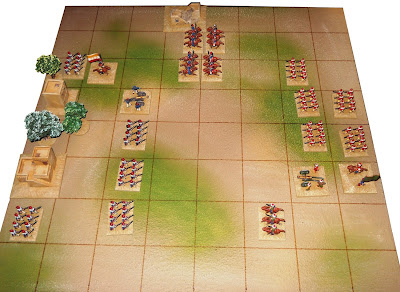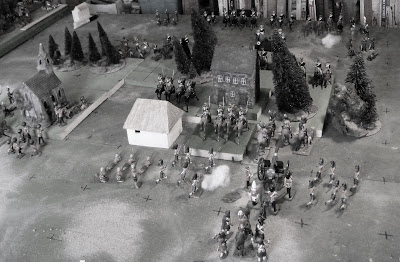The search for more details about POLEMOS has seemingly developed a life of its own, with numerous emails flying about between interested parties, including some of the staff of RUSI (the Royal United Services Institute).
John Bassett – another stalwart member of Wargame Developments and an Associate Fellow of RUSI – has been doing some research, and found an abstract from the eighth international colloquium of the International Society for Board Game Studies, which was held at Oxford in 2005. The abstract is from a paper about JAQUES BOARD GAMES, 1850-1900 by Richard Ballam. It states that:
Nick Huband has also been pursuing his researches into POLEMOS and found an article from THE TIMES that was seemingly reprinted in a New Zealand newspaper, dated 1885. The article states that:
I have also not been idle, and found the following article in a copy of the OTAGO DAILY TIMES of 1899. It states that:
All-in-all, the more I find out about POLEMOS the more my interest grows, especially as my own original portable wargame bears a passing resemblance to that featured in the photographs John Bassett has unearthed.
John Bassett – another stalwart member of Wargame Developments and an Associate Fellow of RUSI – has been doing some research, and found an abstract from the eighth international colloquium of the International Society for Board Game Studies, which was held at Oxford in 2005. The abstract is from a paper about JAQUES BOARD GAMES, 1850-1900 by Richard Ballam. It states that:
In 1885 Polemos (second edition) was played at the Royal United Service Institution and awarded a prize medal at the International Inventions Exhibition.He has also found some excellent photographs of what appears to be a complete POLEMOS game on THE GAMES BOARD website.
Nick Huband has also been pursuing his researches into POLEMOS and found an article from THE TIMES that was seemingly reprinted in a New Zealand newspaper, dated 1885. The article states that:
Under the name of Polemos, a new war game has been invented, and was exhibited at the offices of the United Services Gazette, the other day. It may be described as a kind of military chess, and can be played on a dining table on which is spread a cloth which is marked off in two-inch squares and representing a battlefield ten miles by five. The "pieces" are made of lead, and represent each arm of the service. The players have each an equal number of pieces, and reserves in boxes, and a very instructive game may be played by two or more players. In the game just played no obstructions like rivers, bridges, hills or forests were used, but the inventor explained that these can be added when desired, so as to represent with tolerable accuracy a real battlefield. The moves are sufficiently simple to enable young officers to play the game with very little practice, and the combinations often become sufficiently intricate to interest even field officers. The Mechanics Institute should at once send home an order for a complete outfit for the game of Polemos.It appears that a Lt.-Col. G.J.R. Glünicke – the author of THE CAMPAIGN IN BOHEMIA 1866 and THE NEW GERMAN FIELD EXERCISE – was also the author of the wargame.
I have also not been idle, and found the following article in a copy of the OTAGO DAILY TIMES of 1899. It states that:
A new wargame called “Polemos” has been invented by Dr Griffith, of Brighton. A sheet, divided into inch squares by red lines, is spread on a table, each inch square representing 440 yards. Under this are built up hills or downs; roads, rivers, woods, enclosed grounds, bridges, but not ravines or valleys, are laid out from a map or from fancy, so that the nature of the terrain can be varied illimitably. Towns or villages are represented, and all arms of the service are shown by little coloured leaden blocks. A curtain hides one side of the sheet from the officer commanding the other. He makes his dispositions in secrecy, but is allowed to see a mile and a-half into his enemy’s lines, unless he gains the top of a hill, when he may see three miles. When the troops come into contact gains or losses are claimed by this side or that, and the umpire awards them, although an umpire is not necessary as at the ordinary war game. In fact, the game decides itself. There is no element of chance in it. A move has its consequences, as at chess and in actual warfare. There would seem to be, in a word, as endless an opportunity of combination as in a real campaign. But the objection made to the war game has been applied to Polemos. It is more apt to teach strategy than tactics, and minor tactics scarcely enter into it. At the same time it lends itself to dash, decision, “nerve”, as well as caution, foresight, and the calculation of consequences. The maps in a war game have to be in triplicate, or, at the lowest, in duplicate. A model necessarily occupies a great deal of space. Polemos can be played on an ordinary dining table. The whole apparatus is packed in a box 18in by 12, by about 10in, and it costs only £4 15s. It has, it is stated, been adopted at the Cadet College of Prussia. The game seems to be best played by two persons, but it would be more useful if played by three a side – one to plan, one to execute the movements, and one to learn the moves and the rules, so as to be able without further instruction to take his side in playing the game on some other occasion. Since the game was shown at the Royal Military Exhibition at Chelsea the rules have been much improved.This article seems to be describing a war game with the same name as that produce by Jaques of London, but it may be a later derivation or possibly even a competitor.
All-in-all, the more I find out about POLEMOS the more my interest grows, especially as my own original portable wargame bears a passing resemblance to that featured in the photographs John Bassett has unearthed.




























.jpg)

















.jpg)

.jpg)







